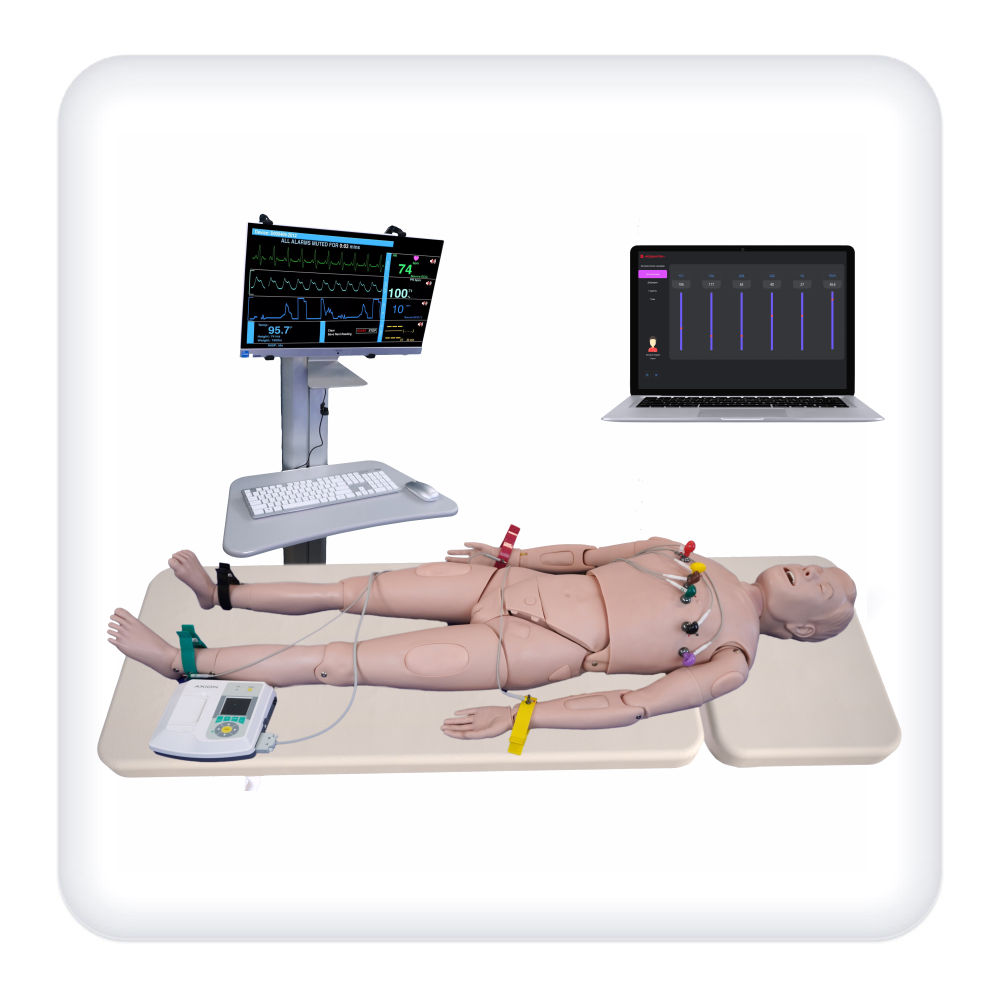The simulator is a full-size model of a real man and is designed to practice the skills of ECG recording and interpretation, heart and lungs auscultation within the framework of the accreditation program in “Cardiology” and “Functional Diagnostics”.
The simulator is equipped with an instructor’s control computer, a computer simulating a patient’s bedside monitor and an ECG machine.
Functional features:
- 12-channel ECG display and interpretation
- Print 12-channel strips from the patient monitor
The instructor’s computer allows to:
- Register students
- Run scripts (particular heart rhythms or auscultatory patterns)
- Record progress
- Debriefing sessions
The bedside patient monitor displays the following indicators:
- ECG in 12 leads
- Heart rate (HR)
- Blood pressure (BP)
- Respiratory rate (RR)
- Respiration curve (Inhalation)
- Blood oxygen saturation (SpO2)
- Body temperature
- Non-invasive blood pressure (niBP)
- CO2 concentration at the end of exhalation (EtCO2)
Heart rhythm library (with the possibility of expanding the database):
- polytopic atrial extrasystole
- atrial flutter
- sinus arrhythmia
- low amplitude
- atrial fibrillation high amplitude
- atrial fibrillation atrioventricular block I degree
- atrioventricular block II degree Mobitz type I
- atrioventricular block III degree
- ventricular monofocal extrasystole
- ventricular multifocal extrasystole
- ventricular extrasystole of the bigeminy type
- interpolated ventricular extrasystole
- early ventricular extrasystole type “R” to “T”;
- paired ventricular extrasystole;
- short run of ventricular tachycardia (triplet)
- tachycardia with a wide QRS complex
- ventricular fibrillation
- ST segment elevation
- ST segment depression
- Wolf-Parkinson-White syndrome
The control computer software allows to run different variations of heart tones and breath sounds.
Heart tone library:
- aortic stenosis
- ventricular septal defect
- atrial septal defect
- mitral stenosis
- mitral valve insufficiency
- normal heart tones
- open ductus arteriosus
- gallop rhythm
- aortic valve insufficiency
- physiological third heart tone
- four-membered rhythm
- pericardial friction noise
- isolated pulmonary artery valve stenosis
Respiratory noise library:
- moist rales
- dry rales
- coarse moist rales
- coarse respiratory sounds
- crepitation
- fine bubbling moist rales
- normal bronchial breathing
- normal vesicular breathing
- pathological bronchial breathing
- intermittent breathing
- wheezing rales
- dry rales (low tone)
- pleural friction rub
Classes are conducted in two modes – training and supervision.
In training mode, the student independently selects a particular pathology and listens for it at standard auscultation sites. When the control mode is selected, the software randomly selects sounds and the student must match them to a specific pathology.
For group listening to the pathologies being studied, it is possible to connect a loudspeaker system with the possibility to output the sound to the auditorium.
Equipment:
- Simulator for practicing ECG recording and interpretation skills
- Laptop
- Personal computer
- ECG machine
Documentation:
- Product passport
- Manual


